Welcome to DU!
The truly grassroots left-of-center political community where regular people, not algorithms, drive the discussions and set the standards.
Join the community:
Create a free account
Support DU (and get rid of ads!):
Become a Star Member
Latest Breaking News
General Discussion
The DU Lounge
All Forums
Issue Forums
Culture Forums
Alliance Forums
Region Forums
Support Forums
Help & Search
Science
Related: About this forumHow a Microbe From Yellowstone's Hot Springs Could Help Feed the World
A Chicago startup has turned a fungus found by NASA into a protein-packed food
Claire Turrell
Freelance writer
March 1, 2024

Minerals and algae form patterns in the scalding hot water at Grand Prismatic Spring in Yellowstone National Park's Midway Geyser Basin. Yellowstone National Park has more than 10,000 thermal features, making it the largest concentration of active geysers in the world. George Rose/Getty Images
In 2009, NASA researcher Mark Kozubal stooped down by the side of a hot spring in Yellowstone National Park. On the harsh acidic water, he could see that a microbe was thriving: A mat of algae had formed on the surface. Carefully taking a spatula, he scooped up a fingernail-sized piece of the algal mat and placed it into a sterile tube.
Kozubal was leading a team of scientists who had been tasked with finding life in this extreme environment filled with steam vents and hot springs. It was research that could prove invaluable for space missions to the moons of Saturn or to Mars. But little did Kozubal know, the microbe he was carrying would be the genesis of one of the world’s most innovative food companies on Earth.
This wasn’t the first time a miracle microbe had been found at Yellowstone. In 1966, scientists found the heat-loving bug Thermus aquaticus that became the foundation of PCR tests. An enzyme from the robust bug can handle the thermal cycles of heating and cooling used in the process of copying DNA.
Kozubal finished his doctorate at Montana State University in 2010, but he didn’t forget about the microbe. He continued to study it. At first, he thought this extremophile could become the source of a new biodiesel, but as gas was so cheap in the United States at that time, it would have been hard to be competitive. The microbe came from the fungus family, so Thomas Jonas, a former president of a packaging company with an interest in science, who Kozubal met through friends, suggested they turn their focus to food.
More:
https://www.smithsonianmag.com/innovation/how-a-microbe-from-yellowstones-hot-springs-could-help-feed-the-world-180983872/
InfoView thread info, including edit history
TrashPut this thread in your Trash Can (My DU » Trash Can)
BookmarkAdd this thread to your Bookmarks (My DU » Bookmarks)
3 replies, 636 views
ShareGet links to this post and/or share on social media
AlertAlert this post for a rule violation
PowersThere are no powers you can use on this post
EditCannot edit other people's posts
ReplyReply to this post
EditCannot edit other people's posts
Rec (18)
ReplyReply to this post
3 replies
 = new reply since forum marked as read
Highlight:
NoneDon't highlight anything
5 newestHighlight 5 most recent replies
= new reply since forum marked as read
Highlight:
NoneDon't highlight anything
5 newestHighlight 5 most recent replies
How a Microbe From Yellowstone's Hot Springs Could Help Feed the World (Original Post)
Judi Lynn
Mar 3
OP
al bupp
(2,179 posts)1. Pretty impressive
Sounds like it could be the subject of another chapter in Merlin Sheldrake's wonderful book on fungi, "Entangled Life".
Faux pas
(14,681 posts)3. Excellent!